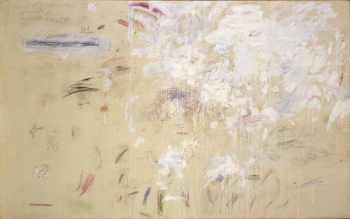Cy Twombly & The School Of Fontainebleau
06 Apr - 07 Oct 2012
CY TWOMBLY & THE SCHOOL OF FONTAINEBLEAU
Curated by Eugen Blume, curatorial assistance: Matilda Felix
6 April - 7 October 2012
Cy Twombly is among the select group of artists represented in the Marx Collection by a comprehensive series of works. Erich Marx initially focused on Joseph Beuys, Anselm Kiefer, Robert Rauschenberg, Cy Twombly, and Andy Warhol when establishing his collection. Key works by these artists are permanently on view in the Kleihues Hall. New hangings enable individual series to be considered in new contexts, thus deepening the viewer's experience of the work.
Cy Twombly & The School of Fontainebleau provides just this kind of re-examination. A cabinet space inside the Kleihues Hall offers an architectural framework for a new look at the abstract paintings of the American artist: In dialogue with these outstanding works by Cy Twombly from the Marx Collection, Hamburger Bahnhof is showing 12 prints and drawings attributed to the School of Fontainebleau from the collection of the Kupferstichkabinett and the Kunstbibliothek (Staatliche Museen zu Berlin).
To consider the works of painter Cy Twombly only within the context of the art movements of the 20th century would not do full justice to his work. The gestural, lavish compositions are too complex, interspersed with small figurative sketches, numbers, words, and quotations. In many cases his canvases are covered with a thick impasto; in others his compositions suggest a generous sense of emptiness. Twombly draws unusual associations between geometric order and chaotic knots of color, figuration and abstraction, image and concept, painting and literature.
Cy Twombly, who was born in 1928 in Lexington (Virginia) and died in 2011 Rome, lived in Italy as of 1960. This move inspired Twombly's engagement with European art history, especially with the 'École de Fontainebleau'.
The School of Fontainebleau is a Mannerist decorative style, which was developed in the mid 16th century in France. Two Italian artists - Rosso Fiorentino (1494-1540) and Francesco Primaticcio (1504-1570) - were commissioned to decorate the Palace of Fontainebleau. They not only designed the paintings, frescos, tapestries, and sculptures required for the official representation of the court, they also used graphic media to disseminate their programmatic style. Through this graphics they influenced artists, such as Nicolas Poussin (1594-1665) up to the 17th century. The often allegorical depictions and amorous-mythological scenes of the historical works add another dimension to the discussion surrounding Cy Twomblys abstracted figuration.
Curated by Eugen Blume, curatorial assistance: Matilda Felix
6 April - 7 October 2012
Cy Twombly is among the select group of artists represented in the Marx Collection by a comprehensive series of works. Erich Marx initially focused on Joseph Beuys, Anselm Kiefer, Robert Rauschenberg, Cy Twombly, and Andy Warhol when establishing his collection. Key works by these artists are permanently on view in the Kleihues Hall. New hangings enable individual series to be considered in new contexts, thus deepening the viewer's experience of the work.
Cy Twombly & The School of Fontainebleau provides just this kind of re-examination. A cabinet space inside the Kleihues Hall offers an architectural framework for a new look at the abstract paintings of the American artist: In dialogue with these outstanding works by Cy Twombly from the Marx Collection, Hamburger Bahnhof is showing 12 prints and drawings attributed to the School of Fontainebleau from the collection of the Kupferstichkabinett and the Kunstbibliothek (Staatliche Museen zu Berlin).
To consider the works of painter Cy Twombly only within the context of the art movements of the 20th century would not do full justice to his work. The gestural, lavish compositions are too complex, interspersed with small figurative sketches, numbers, words, and quotations. In many cases his canvases are covered with a thick impasto; in others his compositions suggest a generous sense of emptiness. Twombly draws unusual associations between geometric order and chaotic knots of color, figuration and abstraction, image and concept, painting and literature.
Cy Twombly, who was born in 1928 in Lexington (Virginia) and died in 2011 Rome, lived in Italy as of 1960. This move inspired Twombly's engagement with European art history, especially with the 'École de Fontainebleau'.
The School of Fontainebleau is a Mannerist decorative style, which was developed in the mid 16th century in France. Two Italian artists - Rosso Fiorentino (1494-1540) and Francesco Primaticcio (1504-1570) - were commissioned to decorate the Palace of Fontainebleau. They not only designed the paintings, frescos, tapestries, and sculptures required for the official representation of the court, they also used graphic media to disseminate their programmatic style. Through this graphics they influenced artists, such as Nicolas Poussin (1594-1665) up to the 17th century. The often allegorical depictions and amorous-mythological scenes of the historical works add another dimension to the discussion surrounding Cy Twomblys abstracted figuration.

